Recent Posts
-
Yes, There IS a Future!
December 26, 2025
-
Real Crimes and the Coming Violence
September 6, 2025
-
Whither Modern Life?
June 27, 2025
-
What the Hell
June 18, 2025
-
As Darkness Engulfs Us
April 6, 2025
-
AI, Risk, and Work
January 17, 2025
-
“Things Are in the Saddle, and Ride Mankind”
December 29, 2024
-
Forgotten Futures in Seattle
December 12, 2024
-
Autocracy Defeats Neoliberalism
November 14, 2024
-
History… We’re Soaking in It!
October 2, 2024
|
Wow. It’s been months since I got it together to blog… if you’ve been waiting, my apologies. Basically I’ve been working on a new book “Critical Mass at 20: SHIFT HAPPENS!” I’m glad to say it’ll be great, but it’s been a lot more work than any of us knew it was going to be… It will be out in time for the 20th anniversary in September 2012. Though I haven’t found time to blog, I had lots of ideas and many photos piling up during these past months so I thought I just throw a bunch of unrelated things up as a kind of “spring cleaning” to make way for more regular posts again. (I also did a huge spring cleaning on the mold in the bathroom, but that was already 7 weeks ago!)
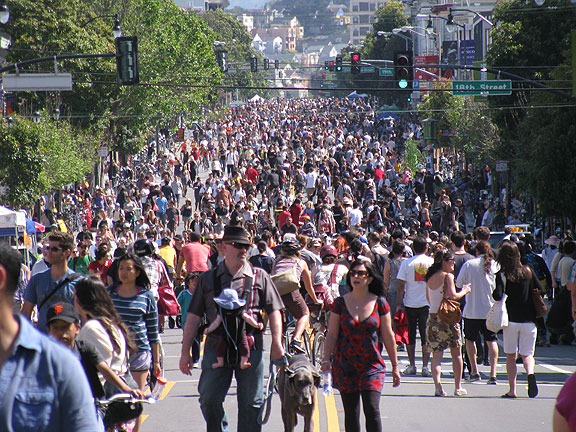 Sunday Streets May 6, 2012, on Valencia looking south from 17th Street. Sunday Streets last weekend was a huge success again, and it will be repeating on the first Sunday of each of the next three months here in the Mission (the neighborhood where it is most loved)… Here’s a few more images, kids and musicians enjoying the respite from the omnipresence of automobiles… When will San Francisco finally start closing streets permanently to cars?
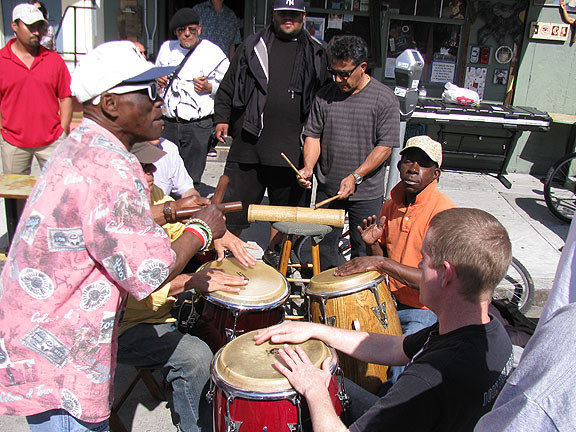 Cuban drummers getting down... 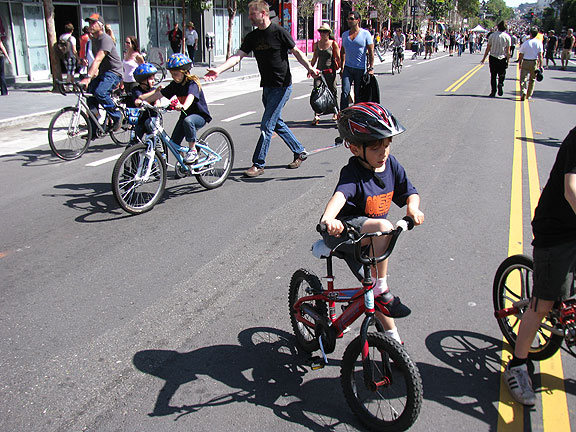 So many kids having so much fun!  Buye Pongo, they were really rockin' it! Last week was May Day… A bunch of us got together back in 1998 to “Reclaim May Day” so I’m delighted to see it has taken on a major life of its own. That said, this past week’s “festivities” seemed rather anticlimactic. Partly because the union bureaucrats pulled the plug on the growing excitement that might have drawn several thousand to a morning blockade and closure of the Golden Gate Bridge. When the union leaders backed off, occupiers and other supporters dutifully followed suit. That led us in the Bike Cavalry to change our plans from riding out towards the Bridge at 7 a.m. and instead we headed downtown to support the Inland Boatman’s Union picket line behind the Ferry Building. When we got there we found our friends in the Brass Liberation Orchestra, and a fun and photogenic kayak picket line in the water.
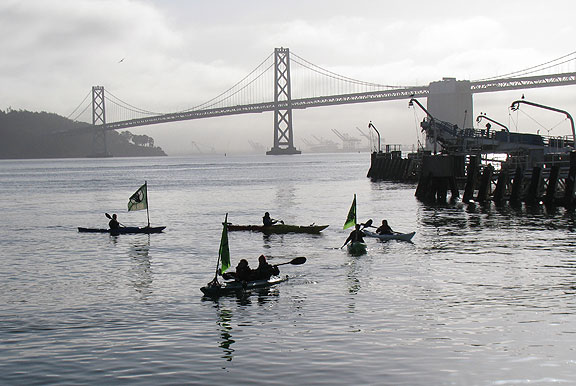 Kayak picket line during morning IBU action on May Day 2012. Continue reading Spring Cleaning
It was a wonderful four days in Porto Alegre, February 24-27! I met hundreds of people, was wined and dined, interviewed nearly 20 times in local and national Brazilian media (including a bit for their equivalent of ESPN, SportTV!), and got to ride in two big rides including the largest ever Critical Mass in Porto Alegre.
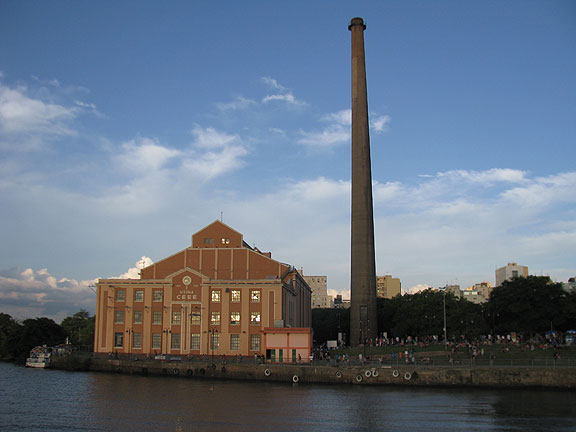 The Gasometro, a former powerplant on the tip of Porto Alegre’s coast, is now a cultural center and was host to the World Bike Forum. Very cool inside, 6 stories high and lots of open spaces to use for meetings and discussions, though we were mostly on the ground floor. 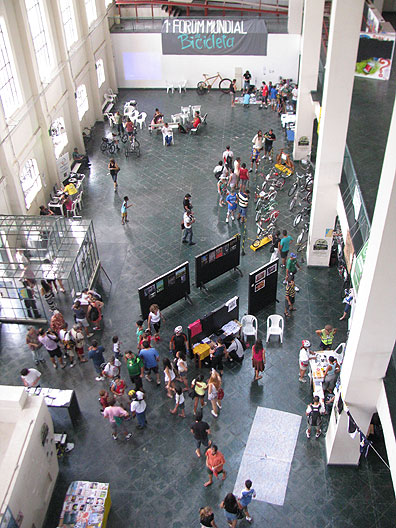 The view looking down at the ground floor from about 4 floors up inside the Gasometro. One year ago, a madman (who is also a vice-president of a local bank) decided he wasn’t going to be delayed by a bunch of cyclists in the road. They had just departed from their customary starting point, turning onto an avenue adjacent to the plaza, and this guy accelerated his car through a block and a half dense with bicyclists. People went flying, bicycles were crushed, and dozens were injured. By some strange miracle no one was killed, but rarely could you find a more obvious case of attempted mass murder. For most of the year since, the local press and population felt sorry for the cyclists and saw them as victims. Meanwhile, hundreds of people started bicycling during that year, some in solidarity and others because it was just so outrageous that it was a way for them to respond directly. (On Critical Mass a young woman I spoke with explained how she started riding after that event, and now had become a daily cyclist. “Since I started bicycling, I’m just happy all the time!”)
About two months ago local cycle activists were worried that the tone in the local media had changed, with bicyclists being accused of being too aggressive, being out of line, being threatening and causing chaos. They decided to organize the first (as far as they knew) World Bike Forum (one might note that there has been a lot of other gatherings of cyclists over the past two decades, from the “Towards Car-Free Cities” conferences to the commercially-minded “VeloCity”; in the U.S. we’ve had the gathering of bicycle cooperatives called Bike!Bike! going on now for a few years). That’s how I came to join them, since they reached out to me to see if I would come and when I said yes, as long as they’d cover my costs, they organized a crowd-funding campaign and over 120 people contributed to my airfare and the costs of the conference.
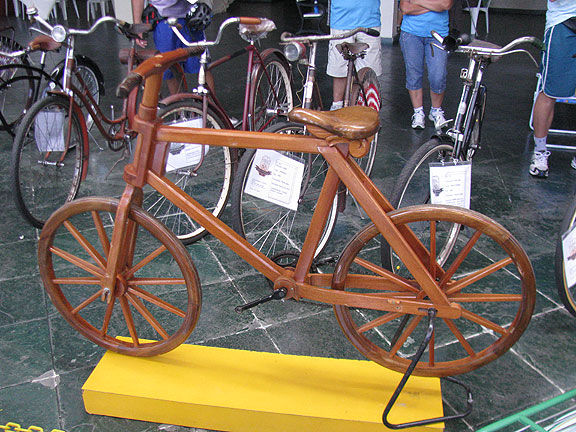 What’s a Bike Conference without a 19th century Boneshaker?!? The many workshops brought together folks around different aspects of cycling culture, from tourism to teaching kids to women’s self-organized cycling, and more. Folks from Caracas Venezuela came, one guy from Chile, a woman from Holland, me from the U.S., and mostly the rest were from around Brazil, including Manaus in the Amazon, Sao Paulo, Rio de Janeiro, Brasilia, Curitiba, and a fair number from small towns in Rio Grande do Sul, the state in which Porto Alegre sits. There was a bunch of films screened on the last day too, and they showed “We Are Traffic!” on the walls with Portuguese subtitles many times during the conference.
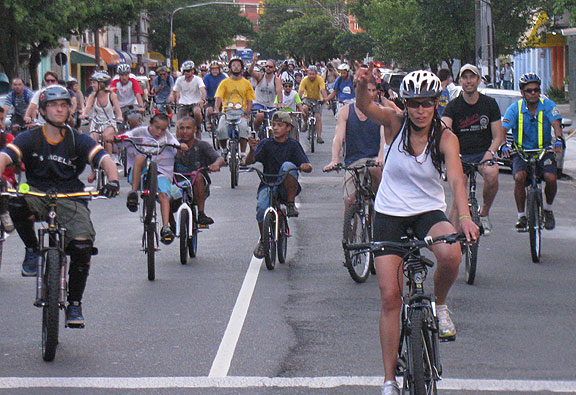 Critical Mass, February 24, 2012, Porto Alegre, Brazil, minutes after beginning… check out that wheelie! The Critical Mass was truly epic. They had their biggest ever Critical Mass after a long day of workshops with hundreds in attendance. About 1700 riders, way over their hoped for 1000…. perfect weather, fantastic spirited participants, whenever we stopped people would clap their hands over their heads, a lot of chanting along the way: “Mais Adrenalina, Menos Gasolina” (more adrenaline, less gasoline) or someone would yell “Bicicleta” and the crowd would roar its answer “Um Carro Menos” (BICYCLE! … One Less Car!)… We rode for about 3 hours all over the city, including up and down main avenues, through the heart of downtown, up and down hills, overpasses and freeway-like ramps (there don’t seem to be any actual freeways here) and through two tunnels, which drove the riders crazy with excitement since they’d never been able to visit these spots by bike before. Continue reading World Bike Forum in Porto Alegre, Brazil
A wide coalition of housing activists, clergy, leftists, unionists, anarchists, and others in San Francisco staged an “Occupy Wall Street West” day of action in downtown San Francisco on Friday, January 20. (The Committee for Full Enjoyment was out too, including yours truly.) It was a cold and soggy day, but a couple of thousand people blockaded, sat in, and protested in front of more than a dozen corporate and government offices, notably Wells Fargo Bank headquarters, Bank of America’s west coast main office, and the Ninth Circuit Court of Appeals. Then on Saturday, January 28, Occupy Oakland staged their “Move-In Day” and marched on the long-empty, publicly-owned Kaiser Auditorium, intending to make it their new social center. Famously now, the Oakland police used teargas and flashbang grenades to repel and disperse the Oakland occupiers. By the time the long day was over, over 400 people had been arrested, many of them in a blatantly illegal round-up of 200 people when police trapped them on Telegraph Avenue in front of the YMCA.
On both sides of the Bay the political confrontations sought to break the ice on the new year by reaching new stages for the local Occupy movement. A day of horizontal direct action and disruption in San Francisco; a dramatic attempt to claim an empty public building in Oakland, followed by a day of police violence. In local circles, while some participants are publicly confident that both efforts in SF and Oakland were “successful” in basic ways, many private conversations I’ve been in have wondered whether or not the local movements are losing broad support. Some people accept the mass media framing of the violence in Oakland as caused by the demonstrators, or at least blame protesters for answering police brutality with anything other passivity or evasion. Others find the tried-and-true sit-ins and blockades staged in San Francisco as ineffective symbolism or even as boring theater, and question the preponderance of left organizations, nonprofits, and unions.
Since the eviction of the Occupy camps late last year, thousands of people have been talking, planning, and wondering what would 2012 bring? How could the best of the past months’ experiences be carried forward and even expanded upon? How could we top the November 2 “General Strike” and Port protest that drew tens of thousands of people into a daylong festival that occupied a good part of Oakland’s downtown before heading over to the Port and stopping shipping for several shifts? Fewer people turned out for the December 12 Port Shutdown in Oakland, though it was still effective for part of the day, along with allied actions in a half dozen other cities. Still fewer came out in the January 20th rain in San Francisco, or a week later to “move in” to the Kaiser Auditorium in Oakland. Signs of trouble? or just to be expected, given the time of year, the nature of the events, etc.?
Maybe, maybe not, only time will tell for sure. But it’s possible that a concerted media campaign to amplify the militant self-defense actions of Oakland protesters has scared away some people and dismayed others. I saw a defender of militant action quoted on a Facebook post that said it was probably a good thing if it scared some people away, since “he couldn’t trust a lot of people politically anyway.” I wonder how prevalent this kind of vanguardist delusion is? What’s been interesting up until now is just how many people have been ready enthusiastically to embrace overtly anti-capitalist rhetoric, albeit amidst a great deal of traditional populism too.
The horizontalist San Francisco Day of Action found itself trapped in what one friend recently dubbed “Big Government Anarchism.” Dozens of self-organized affinity groups, committees, nonprofit activists, and some trade unionists staged their own interventions all over town. In seeking to “crack the corporate piggybank” the Wall Street West occupiers demanded an end to bank evictions and foreclosures, and to put an end to corporate personhood. Targeting threatened homes is practical and as real as it gets. But in the clamor for justice and fairness, there lurks an unspoken faith that social priorities can be changed by a change in government policy. If the government would radically reduce its spending on wars, overseas military bases, corrupt weapons systems, an ever-expanding spook bureaucracy, and a growing prison system, we’d be safer and we’d have money to spend on all kinds of social needs, from housing to health care and food security for all. Take away corporate personhood and an electoral democracy of over 300 million people can become genuinely representative. Really? Continue reading Occupying Our Impasse
|
Hidden San Francisco 2nd EDITION!

NEW 2nd EDITION NOW AVAILABLE!
Buy one here
(Pluto Press, Spring 2025)
|




















